Worlds Apart?
Published in Early Modern History (1500–1700), Features, Issue 2 (Summer 1999), Medieval History (pre-1500), Volume 7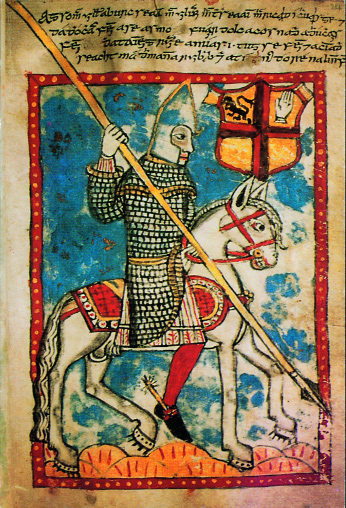
Sir Seán mac Oilibhearuis a Bíºrc, MacWilliam (d. 1580) from the same history and genealogy of the Bourkes used by Ellis on p.25 of the last issue. Note the archaic helmet and armour, out-of-date in European terms, and the Irish practice of riding without stirrups. (Trinity College, Dublin)
It had seriously occurred to me, on readingStevan Ellis’s ‘“More irish than the Irish themselves’?: the“Anglo-Irish” in Tudor Ireland’ (HI Spring 1999), which seems to arguefor a total separation of the ‘Gaelic’ and ‘English’ elements inmedieval Irish history, that this view, expressed with heavy Swiftiansarcasm, represents a deliberate parody. How else could Dr Ellis regardthe red cross on the shield borne (in a sixteenth-century picture) by athirteenth-century de Burgo as a proof of English allegiance; in factthe de Burgo arms may have ante-dated the adoption of the Cross of StGeorge as an English national emblem. (I notice, by the way, that thesame red cross appears on the badge of Alfa-Romeo cars: does Dr Elliswant us to draw the same conclusion there?) And the parody theory isstrengthened by his extraordinary suggestion that Bunreacht na hÉireannmight have claimed as the national territory not, as it did, ‘theisland of Ireland’, but ‘the traditional Gaedhealtacht’. The framers ofthe 1937 Constitution (to whom Irish history between 1169 and 1798 wasprobably something best forgotten) would have replied that the wholeisland was the traditional, pre-1169, Gaedhealtacht. Besides, in termsof practical politics, it was precisely in that part of Ireland whichwas most firmly embedded in the late medieval Gaedhealtacht, Ulster,that the constitutional claim to the whole island was bitterly resented.
The main weakness of Dr Ellis’s argument is the imprecision of hisconcepts, his use both of what are called in logic ‘undivided middles’,that is, terms which are in fact being used to cover two or moredifferent concepts, and of the kindred error of treating two differentconcepts as the same, such as equating ‘home rule’ (i.e. localautonomy) with ‘separatism’.
Who were the Gaill ?
Ellis’s ‘two nations’ between which late medieval Ireland was‘partitioned’ [his word] are the Gaedhil and the Gaill, identified withthe ‘loyal English lieges’ of Ireland. But this was not the meaning ofGaill. For example, in 1414 Sir John Stanley, Governor of Ireland,plundered the Gaelic poet Niall Ó hUiginn; in revenge Henry Dalton,under whose protection Ó hUiginn had been living, plundered ‘the King’speople’ (muinntear an Righ) in order to make good Ó hUiginn’s losses.
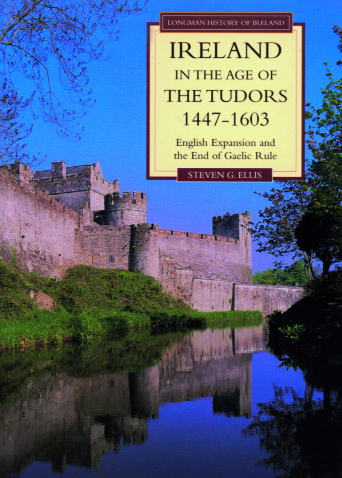
Cahir Castle, from the cover of Steven Ellis’s Ireland in the Age of the Tudors 1447-1603. The Butlers of Cahir, who allied themselves to the Desmonds, were more ‘Gaelic’ in their style of rule than the other Butlers. (The Slide File, Dublin)
Here ‘the King’s people’ are clearly the ‘loyal English lieges’. ButHenry Dalton himself was a Gall; neither he nor any of hiscontemporaries would have claimed otherwise. Dr Ellis declares that ‘inreality not a single Gall ever became a Gaedheal’. This is an absurdtruism. The modern equivalent would be to doubt the nationalism ofPatrick Pearse, on the ground that ‘he never acquired an Irish father’.Being a Gaedheal was a genealogical identity, implying patrilinealdescent from Míl of Spain, whose sons led the last ‘legitimate’conquest of Ireland, and had nothing to do with cultural identity;those whose ancestors arrived later were the Gaill. One could notbecome a Gaedheal any more than one could change one’s grandfather. ButGaill could and were often monoglot Irish speakers, who followed Irishlaw and Irish life styles.
The Gaill then were not the same as the loyal English lieges,although they certainly included the latter. But were the latter asclearly-cut and defined a body as Dr Ellis thinks? In 1459 MeylerDelamare (or Fear Dorcha mac Hoireabaird, as his Gaelic neighbours knewhim) ‘captain of his nation’, obtained a grant from the IrishParliament towards rebuilding his castle of Street, which had beendestroyed by his enemies. By the late sixteenth century the Delamarecaptaincy was passing, as we are explicitly told, by ‘tanistry’ withinthe derbfine kin-group. In other words, the Delamares had in themeantime abandoned the use of English law. Dr Ellis sees early TudorIreland as ‘another Tudor province inhabited by peoples [sic] who sawthemselves as English and were governed by English law andadministrative structures’. True enough, if he is talking about thePale, the southern strip of County Wexford and the isolated port towns,although one must have reservations: bilingualism was certainlyspreading in these English-speaking areas and by the late sixteenthcentury was probably nearly universal (Fynes Morison angrily commentedthat the townsfolk, outside Dublin, commonly conversed among themselvesin Irish rather than English). The maps that illustrate Dr Ellis’sbooks suggest that he intends his description to extend further,perhaps to the areas shown there as ‘English Marches’ includingKilkenny and much of Munster. This is the area—Kilkenny, Tipperary andWaterford—which the citizens of Waterford described to the IrishParliament in 1476 as ‘not governed by the King’s laws but only by thatevil and damnable law called brehon law’. With regard to the origin ofthat situation, Dr Ellis mocks those who would see the fourth, ‘White’,Earl of Ormond as a ‘separatist’. If by this he means someone whorejected the authority of the English crown, I know of no-one who hassuggested that: if he means ‘practiser of local autonomy’ he is wrong,for we know that the White Earl was prepared to bypass English law andEnglish administrative structures when in 1433 he annexed the royalcounty of Kilkenny and the Cross (church) lands there and in Tipperaryto his liberty of Tipperary, as ‘one country under one rule and onelord’. The government in London, we may assume, did not know: theofficials in Dublin may have had some knowledge of this totally illegalproceeding, but if they did, since they had no way of enforcing theirauthority in Kilkenny, they must have ignored it. And the Earl broughtin and endowed one of the MacClancy brehons for his legal counsel.
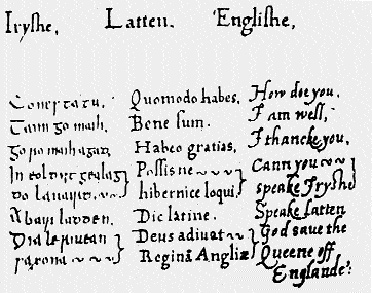
Page from Primer of the Irish Language presented to Elizabeth I in 1564 by Christopher Nugent, Baron of Delvin.
(AsKatherine Simms has pointed out, overwhelming evidence shows that theGaelic brehons in these so-called ‘English’ areas were not employedsimply for the use of a hypothetical Gaelic under-class, but for thewhole population.) When in 1478 the White Earl’s grand-nephew, JamesButler, as deputy to the absentee Earl of Ormond, along with the otherButler chiefs and the Archbishop of Cashell, issued a code of criminallaw at Kilcash, it was again not only for the Ormond Liberty ofTipperary but for County Kilkenny and the Cross lands as well, areaswhich should in theory have been under the direct control of the Crownand the Common Law. And the Kilcash statutes, based on fines andcompensation, bear no resemblance whatever to English common law. Whatgoes for the Butler areas, on which we are so well informed, goes alsofor the rest of ‘English’ Munster.
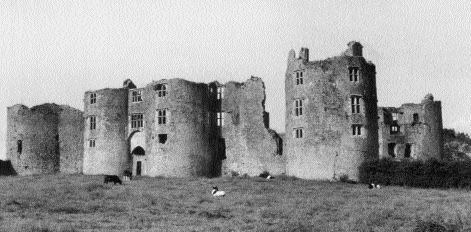
Roscommon Castle-in 1416 an official document claimed that the O’Conors held it ‘for the King’s use’! (Tom McNeill, Castles in Ireland)
As English control over the southand west of Ireland disintegrated during the course of the fourteenthand early fifteenth centuries, the lords assumed of their own authoritythe local jurisdictional power which was normal in most Europeanmonarchies (including Scotland) and which they found essential to theirsurvival, but which was no longer tolerated—outside the so-called‘March of Wales’—in the English realm. And this power createdoutside—and indeed in opposition to—the framework of English law, washeavily influenced by the institutions of the Gaelic Irish, just asGaelic Irish institutions were influenced by English and feudal ones.This is why we employ the term ‘Gaelicisation’ to which Dr Ellisobjects so strenuously.
English Ireland and the Anglo-Scottish border
So we are left with a much smaller ‘English Ireland’, certainly notcoterminous with the area ruled by lords of ‘English’ descent. Withregard to this limited area, there is merit in the comparison drawn byDr Ellis with the northern border counties of England. Both regionswere liable to endemic border brigandage and to occasional devastatinginvasions: there were similarities in social and politicalorganisation. But if there were analogies, there were also profounddifferences. The borders of ‘English Ireland’, unlike theAnglo-Scottish Border, were fluid and liable to change in bothdirections, and the political situation on their other side was totallydifferent from that in Scotland. Not even the Dacres would havedeclared, when called to order by a royal representative, that ratherthan accept his commands ‘they would become Scottish every of them’, asthe ‘loyal English lieges’ of Ireland informed Sir Richard Edgecombe in1488 that, rather than accept his demands for a more stringentlydefined allegiance, ‘they would become Irish every of them’. Nor wouldeven that politic Welshman, Henry VII, have accepted such a declarationfrom his English borderers as he apparently did from his Irish lieges.For both he and Edgecombe would have appreciated that the twostatements, the actual Irish and the hypothetical Border one, meantsomething totally different. To become Scottish would have been towithdraw one’s allegiance from the King of England and give it to arival monarch; to become Irish meant only to abandon the law andadministrative institutions maintained in the name of the English king.By ‘becoming Irish’ these lieges of Ireland meant that they wouldfollow the example of their neighbours the Dillons, the Daltons and theTyrrells, as well as the Butler and the Munster lords, by abandoningthe common law and assuming jurisdictional autonomy. But, in doing so,they would not see themselves as rejecting their ultimate allegiance tothe English Crown.
The Gaedhealtacht: not a mirror-image of England
Historians of the English tradition, Irish as well as English, havetended to see the English model of centralised royal authority, legaluniformity and the virtual absence of devolved jurisdictions as a norm,although in European terms it is quite exceptional. Therefore, thehypothetical Gaedhealtacht must be conceived by them in the same terms,a ‘Gaelic system’ as closed and exclusive as the common law. AmongIrish nationalists there has been a perception that to suggest thatIreland was unlike England is to denigrate it, for England is the normagainst which all things must be measured. When, many years ago, I waspreparing historical maps for the New History of Ireland the theneditor, the late T.W. Moody, took exception to my marking those areasoutside the effective control of the royal administration as preciselythat—he wanted some such caption as ‘Areas of autonomous Gaelic rule’.Gaelic rule must be as organised and exclusive as English. Thisattitude, in its extreme form, was cruelly summed-up by the late DanielBinchy in regard to Eoin MacNeill: that MacNeill wished to demonstratethat early Ireland was as modern and up-to-date as Victorian England!It is this notion of the Gaedhealtacht as a closed and exclusivepolity, a mirror-image of the English realm, which leads Ellis toreject the term ‘Gaelicisation’ so fiercely; he sees it as implying atotal rejection of all elements that came from the English, or indeedthe feudal, heritage. But of course it implies nothing of the kind. An‘English’ lord who became ‘Gaelicised’ did not thereby abandon thosefeudal or English institutions which he found still valuable orprofitable. When in 1519 and 1520 Lord Barry sells an exemption fromthe exactions which he was levying, at the end of a list of Gaelicterms—coinnmheadh, aithne, soirthean, conairte, srath, ceithearn tigh,and cion dubh, all exactions quite unsanctioned by English law—we find‘royal service’, and the ‘feudal levy on knights’ fees’. And the causeof Barry selling one of these exemptions was to raise funds to enablehim to attend parliament in Dublin!
The Scottish Gaedhealtacht
Dr Ellis, in his other writings, has rightly emphasised the continuitybetween the Irish and the Scottish Gaedhealtachta, but fails to seethat the Scottish Gaedhealtacht does not lend support to his view ofthe Irish one. For the Scottish Gaedhealtacht was in every sense anintegral part of the kingdom of Scotland. Even if the MacDonald Lordsof the Isles occasionally entertained the hope of reviving, withEnglish help, the independent Kingdom of the Isles, their normal stancewas as barons of the kingdom of Scotland, in whose parliament they sat.
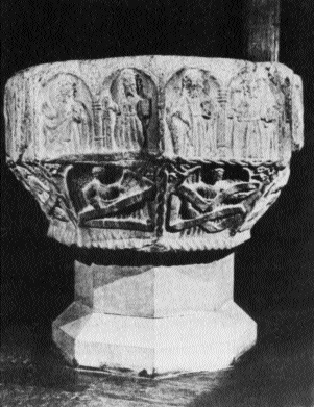
The early sixteenth-century font of St Peter’s (Church of Ireland), Drogheda, where Octavian is buried, may have been commissioned by him. (Con Brogan)
And, in spite of Ellis’s denial that Gaelicisation occurred inScotland, many of the lineages of the Scottish Gaedhealtacht were byorigin Gaill—the Frasers, the Grants and the Stewarts of Appin springimmediately to mind. The question of political ‘Gaelicisation’, in thesense in which the term is used in Ireland, did not arise in Scotland,where the devolved system of feudal jurisdictions (which endured until1748) permitted flexible adaptations to local conditions, as we cansee, for example, in the Campbell earldom of Argyle.
The integration of the Scottish Gaedhealtacht into the Scottishkingdom proceeded from the fact that Anglo-Norman settlement andfeudalisation in Scotland were put in place by a native dynasty ofGaelic origin. In Ireland where not only did both these processes occuras a consequence of English conquest, but the succeeding Englishmonarchs refused to accept and assimilate the Gaelic Irish as theirsubjects, things were very different. The people of the Gaedhealtachtwere seen, not as subjects, but as ‘the King’s Irish enemies’.
Acceptance of nominal English sovereignty
But just as the fourteenth-century crumbling away of English power inIreland allowed the ‘English’ lords to seize the jurisdictionalautonomy which they had been denied in the English system, so it alsofreed the Gaelic rulers from the practical disadvantages,discrimination in law and land holding, which had previously attendedtheir recognition of English sovereignty. The spirit of rejection ofEnglish rule, embodied in Domhnall O’Neill’s famous Remonstrance of1317, dwindled away along with the English authority to which it hadarisen in opposition. Colonial governors, faced with a disintegratingfrontier, made the best of the situation by making leases and grants oflands to Gaelic chieftains. Sir Thomas Rokeby’s grant of extensivelands to Cormac MacCarthy in 1356 was unique only in its size: it set apattern of MacCarthy co-operation with the Crown which continued intothe sixteenth century. In 1365 Cormac’s son Domhnall, Rí Deasmhumhan tothe Irish, ‘Captain of the Irish of Desmond’ to the English, obtainedlicense from the Lord Lieutenant, Lionel of Clarence, to make an entailof his lands according to the forms of English law, and the deed ofentail was duly enrolled on the Irish Chancery Rolls. When Richard IIcame in person to Ireland in 1394, all the Gaelic rulers, with thesolitary exception of Toirdhealbhach Ruadh O’Conor, contender for thekingship of Connacht, came and submitted to him. Toirdhealbhach Ruadhmay have been carrying on the earlier tradition of the Remonstrance:there is some evidence that, like England’s enemies France andScotland, he supported the Avignon papacy. But his rival,Toirdhealbhach Óg, made full use of Richard’s visit; accompanying hisclose ally William Burke of Clann Riocaird to Waterford, where the kingwas about to take ship, he obtained from him not only the honour ofknighthood and the rights of English law—including the right to acquireland—but also jurisdiction over his sub-lords such as O’Dowda andO’Hara and the formal constableship of the royal castle of Roscommon,which his kindred had seized by force forty years before. CalvachO’Connor of Offaly (d. 1458) is remembered as a mighty Gaelic warrioragainst the English, but we know from contemporary English sources thathe took the trouble to obtain formal legal conveyances of the lands hehad occupied from their—perhaps nominal—’English’ owners. It is clearfrom these and innumerable other examples that the notion of an IrishGaedhealtacht set apart from the English colony and rejecting theauthority of English sovereigns is a myth, a conclusion which wouldsurely be as unpalatable to the nationalists whom Dr Ellis claims todecry as it must be to himself. If, for practical purposes, the Gaeliclords of Ireland were totally outside the control of the English Crown,the same was true of their ‘English’ contemporaries outside the narrowcolonial area which I have referred to. There is no evidence that theGaelic rulers of the late fifteenth century rejected the authority ofthe English king—so long as it remained purely nominal—any more thantheir ancestors had rejected that of Richard II. It is noteworthy thatthe one Irish lord of this period who came nearest to rejecting theEnglish Crown was not a Gaedheal but one of Dr Ellis’s ‘English ofIreland’, the tenth Earl of Desmond, whose ancestor, after all, hadplotted to throw off English rule two centuries earlier.
Operating in two worlds: the Kildares
Steven Ellis is scornful of what he sees as the contradiction ofalleging increasing Gaelicisation of ‘English Ireland’ at a time when,under the early Tudors, the political power of the Gaill was on theincrease. But the confusion of thought is his: the Gaill in questionwere the Kildares, who—as he himself acknowledges elsewhere—used Gaelicpractices and Gaelic law side by side with English, according to thearea they were operating in, and had no hesitation in employing GaelicIrishmen in important functions, as in the successive Gaelic constablesof Carlow castle from the 1490s onwards. But in any case, even if theKildares had been purely English—which they were not—there would benothing contradictory in the extension of their power coinciding withcultural Gaelicisation: the use of the Gaelic language and an interestin Gaelic literature seen to have been increasing among the ‘English’of the Pale contemporaneously with the Tudor reconquest. The case ofthe Nugent family of Delvin, who produced in the Elizabethan period onewriter of fluent bardic verse, is well-known, but when in 1591 theLondon authorities looked around for somebody who could translate anintercepted letter in Irish they lit upon Lord Dunsany, then in London,who duly obliged: it is obvious he had more than ‘kitchen Irish’.
The Kildares, like the White Earl of Ormond a century earlier,operated simultaneously in two different worlds; English magnates onone hand, autonomous Gaelicised lords on the other. Themselves marryingEnglish wives, they married off their daughters and junior kinsmen toGaelic or completely Gaelicised spouses. Such a dual identity no doubtoffends the tidy English mind, whether embodied in a Tudor official ora modern historian, but to Ormond or Kildare, if they thought about itat all—which I doubt—it would have seemed perfectly natural. Nor was itso unusual in a European context: the Duke of Bar was a subject of theking of France for half his duchy, of the German Emperor for the otherhalf. The Irish case was a much simpler one, for there was noalternative allegiance involved.
Medieval Germany a better model for Ireland
The centralised and—uniquely in Europe—legally exclusive English polityis a very unsuitable model for fifteenth-century Ireland. Perhaps if welooked at Germany in the same period we would find a better one. InGermany, where the power of the Emperor had declined to little morethan nominal, internal borders were ill-defined and jurisdictions oftenin conflict. The stronger lords, such as the Counts Palatine, imposedtheir authority on their weaker neighbours, and the holders of feudallordship—grundherrschaft—found themselves sidelined and reduced toimpotence by those who held the right of ‘protection’, vogtei, whichallowed them to tax and demand military service. A parallel in Irelandmight be the way in which particular knightly families, such as theDillons and Daltons in Westmeath, had imposed their authority on theirneighbours and former equals. All in all, the German picture is one ofpolitical and administrative chaos. In the absence of an overallenforcing authority, power will become diffused and its manifestationslocally diverse. This is the pattern which we would expect to find, anddo find, in fifteenth-century Ireland: a diversity of degrees ofAnglicisation and Gaelicisation, not a country divided—as Dr Ellisassumes—by a rigid frontier into an English province and aGaedhealtacht which, in spite of lacking any central authority, somehowmanages to mirror the uniformity of the other.
Dr Ellis claims to be refuting nationalist views of Irish history,but it seems to me that his argument, if followed to its logicalconclusion, points in precisely the opposite direction. For if onerejects—as he appears to—the ‘Irishness’ of anything that has anEnglish connection, one is left with the crudest kind of nationalistpseudo-history: ‘the struggle of the Gael [sic] against the alienintruder’. I find it hard to accept that this is his intention.
Kenneth Nicholls lectures in history at University College Cork.
Further reading:
K. Simms, ‘Bards and Barons: the Anglo-Irish aristocracy and nativeculture’ in R. Bartlett and A. MacKay (eds.), Medieval FrontierSocieties (Oxford 1989).
K.W. Nicholls, ‘The Development of Lordship in County Cork, 1300-1600’in P. Flanagan and C. Buttimer (eds.), Cork: History and Society(Dublin 1993).
K.W. Nicholls, ‘Anglo-French Ireland and After’ in Peritia, I (1982).


















